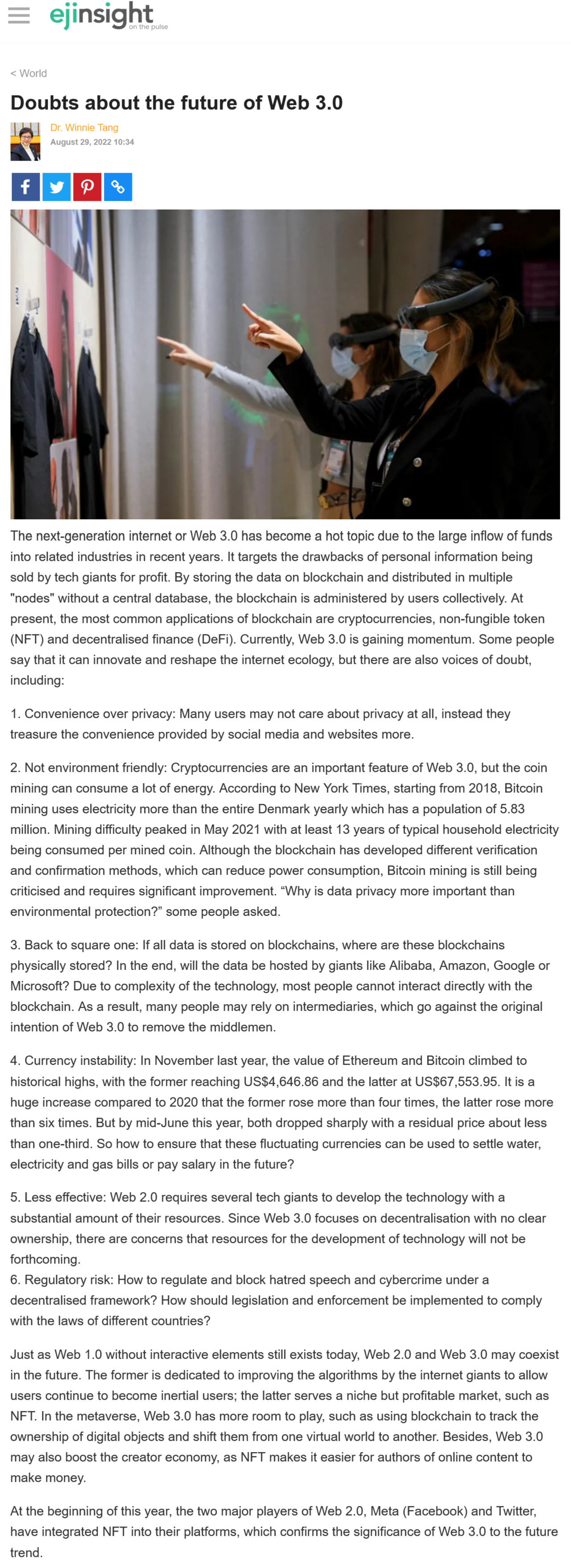網上版請按此

Doubts about the future of Web 3.0
The next-generation internet or Web 3.0 has become a hot topic due to the large inflow of funds into related industries in recent years. It targets the drawbacks of personal information being sold by tech giants for profit. By storing the data on blockchain and distributed in multiple "nodes" without a central database, the blockchain is administered by users collectively. At present, the most common applications of blockchain are cryptocurrencies, non-fungible token (NFT) and decentralised finance (DeFi). Currently, Web 3.0 is gaining momentum. Some people say that it can innovate and reshape the internet ecology, but there are also voices of doubt, including:
1. Convenience over privacy: Many users may not care about privacy at all, instead they treasure the convenience provided by social media and websites more.
2. Not environment friendly: Cryptocurrencies are an important feature of Web 3.0, but the coin mining can consume a lot of energy. According to New York Times, starting from 2018, Bitcoin mining uses electricity more than the entire Denmark yearly which has a population of 5.83 million. Mining difficulty peaked in May 2021 with at least 13 years of typical household electricity being consumed per mined coin. Although the blockchain has developed different verification and confirmation methods, which can reduce power consumption, Bitcoin mining is still being criticised and requires significant improvement. "Why is data privacy more important than environmental protection?" some people asked.
3. Back to square one: If all data is stored on blockchains, where are these blockchains physically stored? In the end, will the data be hosted by giants like Alibaba, Amazon, Google or Microsoft? Due to complexity of the technology, most people cannot interact directly with the blockchain. As a result, many people may rely on intermediaries, which go against the original intention of Web 3.0 to remove the middlemen.
4. Currency instability: In November last year, the value of Ethereum and Bitcoin climbed to historical highs, with the former reaching US$4,646.86 and the latter at US$67,553.95. It is a huge increase compared to 2020 that the former rose more than four times, the latter rose more than six times. But by mid-June this year, both dropped sharply with a residual price about less than one-third. So how to ensure that these fluctuating currencies can be used to settle water, electricity and gas bills or pay salary in the future?
5. Less effective: Web 2.0 requires several tech giants to develop the technology with a substantial amount of their resources. Since Web 3.0 focuses on decentralisation with no clear ownership, there are concerns that resources for the development of technology will not be forthcoming.
6. Regulatory risk: How to regulate and block hatred speech and cybercrime under a decentralised framework? How should legislation and enforcement be implemented to comply with the laws of different countries?
Just as Web 1.0 without interactive elements still exists today, Web 2.0 and Web 3.0 may coexist in the future. The former is dedicated to improving the algorithms by the internet giants to allow users continue to become inertial users; the latter serves a niche but profitable market, such as NFT. In the metaverse, Web 3.0 has more room to play, such as using blockchain to track the ownership of digital objects and shift them from one virtual world to another. Besides, Web 3.0 may also boost the creator economy, as NFT makes it easier for authors of online content to make money.
At the beginning of this year, the two major players of Web 2.0, Meta (Facebook) and Twitter, have integrated NFT into their platforms, which confirms the significance of Web 3.0 to the future trend.
Dr. Winnie Tang
Adjunct Professor, Department of Computer Science, Faculty of Engineering; Department of Geography, Faculty of Social Sciences; and Faculty of Architecture, The University of Hong Kong